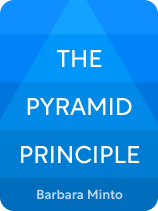

This article is an excerpt from the Shortform book guide to "The Pyramid Principle" by Barbara Minto. Shortform has the world's best summaries and analyses of books you should be reading.
Like this article? Sign up for a free trial here.
Do you know how to brainstorm ideas for writing? Why is it important to brainstorm?
Before you pick up a pencil to start writing, it’s important you brainstorm your ideas first. In The Pyramid Principle, Barbara Minto says this is crucial because you must know your purpose before anything else.
Read below to learn how to brainstorm ideas for writing papers or any other prose.
Brainstorming Your Ideas
Here we’ll describe two steps to learn how to brainstorm ideas for writing: clarifying your topic and filling out the Conclusions-First Pyramid. We’ll illustrate these two steps using this one example: Imagine you’re sending an email to your neighborhood mailing list about your city’s upcoming composting program.
Step 1: Clarify Your Purpose
According to Minto, before you fill out your pyramid, you must clarify your purpose: what you want your piece to teach your readers. Minto claims that all readers are motivated to read so that they learn something new. To ensure you’ll fulfill this motivation, brainstorm answers to these two questions:
Question 1: What main question would your readers have about your topic? For example, if your topic is your city’s new composting program, your neighbors might wonder, “Should I compost?”
(Shortform note: Before determining your question, it may be helpful to pinpoint who your audience is and why they’re reading your piece. Briar Goldberg, the director of speaker coaching at TED, argues that public speakers should try to align their message with their audience’s goals. This makes it more likely that they’ll find your speech useful and memorable. You can apply this same idea to your writing, as well. While brainstorming your question, follow this advice from Goldberg: Consider who your audience is, why they’re taking time to pay attention to your ideas, and what they’ll likely want to gain from your ideas.)
Question 2: What’s your answer to your reader’s question? This answer will be your Peak Conclusion. For instance, your answer to the question “Should I compost?” might be “You should compost.” However, Minto points out that you may not always know your answer this early in the brainstorming process. In this case, skip brainstorming your answer—you’ll formulate it in the next step.
(Shortform note: How can you generate a strong, compelling answer to your reader’s question? In Get to the Point!, communication expert Joel Schwartzberg argues that a strong point (or in this case, a strong Peak Conclusion) meets these two criteria: 1) It’s an idea someone might disagree with, and 2) it requires analysis to explain. A conclusion that meets these criteria goes beyond what’s obvious, which justifies the existence of your written piece. For instance, the conclusion that you should compost meets Schwartzberg’s first criterion because someone could form a reasonable argument about why you shouldn’t compost. Furthermore, this conclusion meets Schwartzberg’s second criterion because you must include analysis to thoroughly explain why you should compost.)
Step 2: Fill Out the Conclusions-First Pyramid
After you clarify your purpose, your next step is to use the Conclusions-First Pyramid to structure your ideas. According to Minto, there are two approaches to filling out the pyramid: a peak-to-base approach and a base-to-peak approach. The first approach has you fill out the pyramid from the top down. Minto recommends using the peak-to-base approach if you’ve already formulated an answer (the Peak Conclusion). By contrast, the base-to-peak approach has you fill out the pyramid from the bottom up. Use this approach if you haven’t yet brainstormed a Peak Conclusion or if the peak-to-base approach didn’t work for you.
Here, we’ll further explain how to use each approach.
Approach 1: The Peak-to-Base Approach
Minto claims that when you already have your Peak Conclusion in mind, you can generate your remaining ideas by imagining you’re having a dialogue with a skeptical reader: someone who asks follow-up questions about each idea in your pyramid, starting at the peak. Your answers to their questions about the Peak Conclusion will become your Tier 1 ideas. If they continue to have questions about your Tier 1 ideas, you’ll answer those questions in Tier 2. Continue this process of adding tiers to your pyramid until you answer all of the skeptical reader’s questions.
For example, imagine a skeptical reader encounters your Peak Conclusion for the composting email: “You should compost.” They’ll most likely wonder, “Why?” The diagram below illustrates how your answers to this question form the conclusions in Tier 1. A skeptical reader would likely continue to have questions about these Tier 1 ideas. You can find the answers to those questions in Tier 2.
Approach 2: Base-to-Peak Approach
According to Minto, a base-to-peak approach is a strong alternative to the peak-to-base approach, especially if you’re having trouble formulating your Peak Conclusion and/or your Tier 1 conclusions. To use the base-to-peak approach, follow these four steps:
Step 1: List ideas that answer your audience’s question. For example, in response to the question, “Should I compost?”, generate two lists: one list with reasons why a reader should compost, and one list with reasons why they shouldn’t compost.
Step 2: Group your ideas based on their similarities. For instance, imagine you generated these four reasons why your reader should compost:
- The city will convert your organic waste into compost you can use in your garden.
- You’ll be entered into a raffle for a gift card to the gardening store.
- Using compost in our garden will reduce greenhouse gas emissions.
- Composting will divert our organic waste from landfills.
The first and second ideas are both reasons why composting benefits the individual reader. The third and fourth ideas are both reasons why composting benefits the community.
Step 3: Generate a conclusion for each group and insert them into your pyramid. For example, this conclusion summarizes the first group of ideas: “Composting benefits you.” The conclusion summarizes the second group of ideas: “Composting benefits the community.” Write these conclusions in Tier 1, and write the specific supporting ideas from Step 2 in the tier below these conclusions.
Step 4: Generate a Peak Conclusion from your group conclusions. For example, write “You should compost” at the top of your pyramid.

———End of Preview———
Like what you just read? Read the rest of the world's best book summary and analysis of Barbara Minto's "The Pyramid Principle" at Shortform.
Here's what you'll find in our full The Pyramid Principle summary:
- How to write so clearly that you can get a point across within 30 seconds
- How to write a clear, compelling introduction, body, and conclusion
- Why you should always start your prose with your conclusion and work backward






